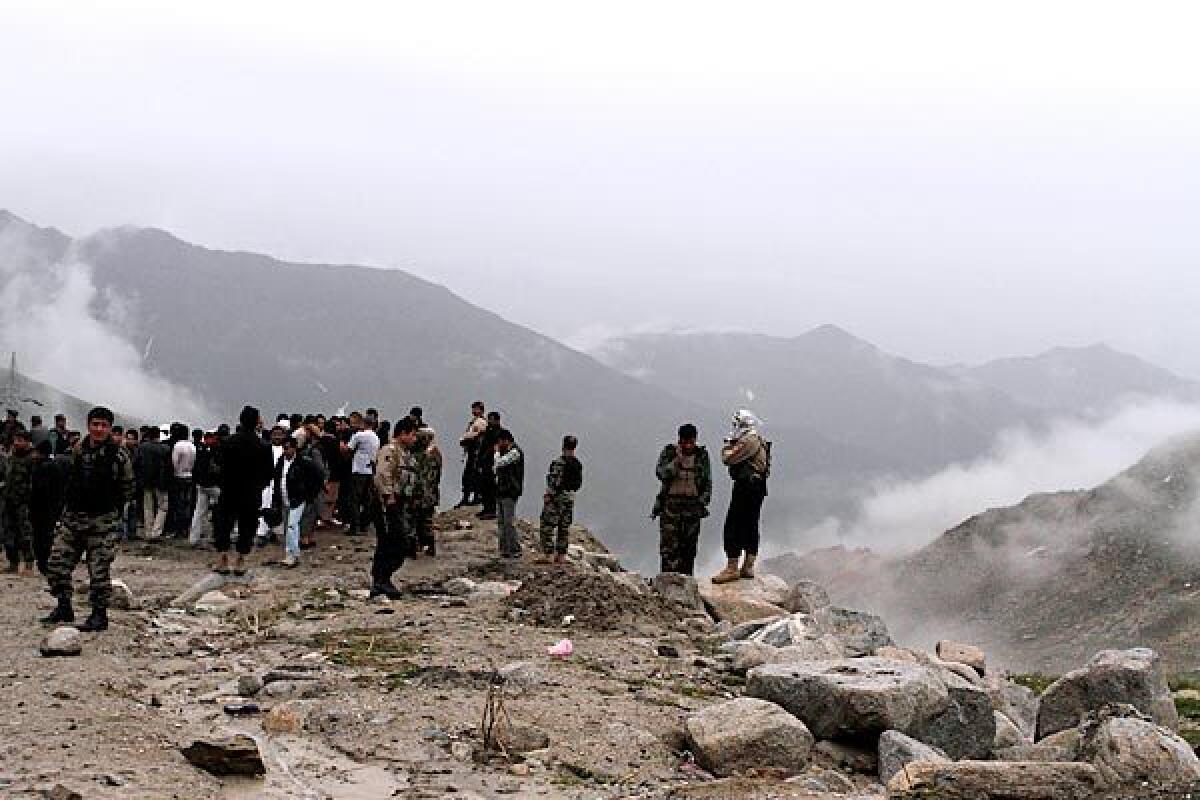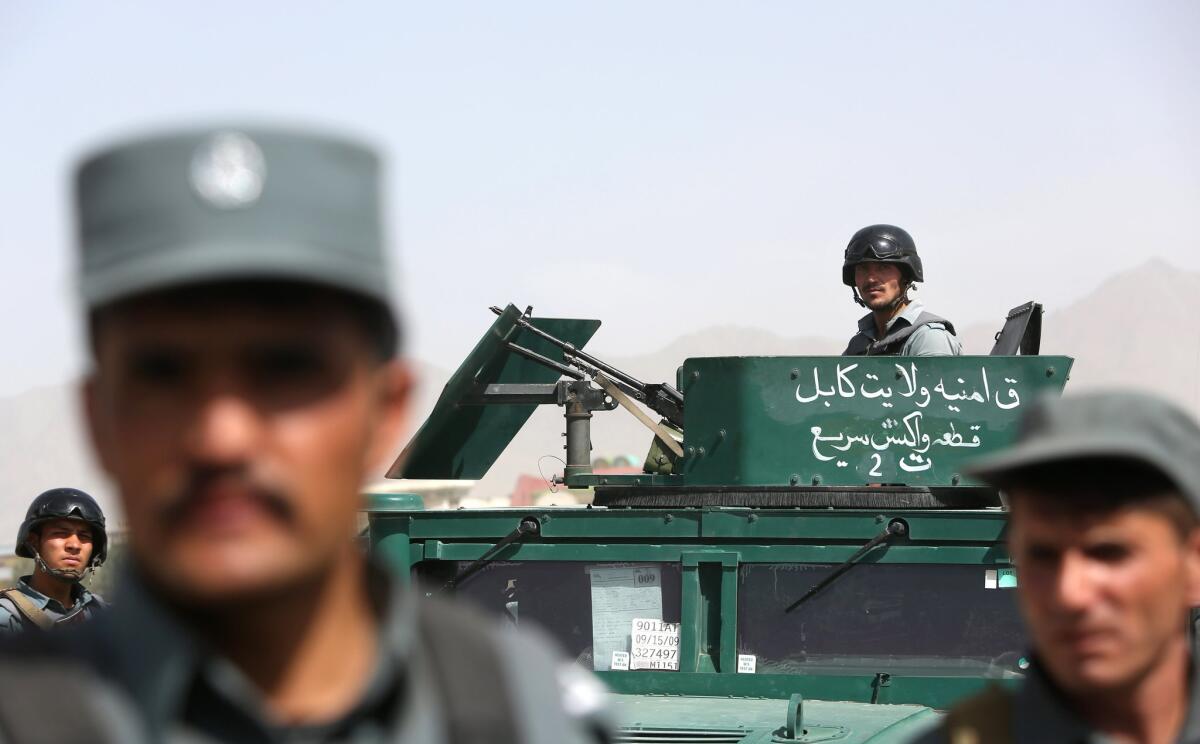God, gas and heroin. Now, the fight’s over water

- Share via
ZARANJ, Afghanistan — Men across this windblown, lawless desert have fought over opium, God and gasoline, but now, Said Mohammed, a wheat farmer with a shovel and a rifle, senses a war brewing over water.
The conflict runs along the dangerous border between Afghanistan and Iran, where the Helmand River winds like an existential thread through two troubled lands. The nearly complete Kamal Khan dam would provide Afghan farmers with steady irrigation flows in dry seasons. But Iran, claiming the dam may significantly reduce its downriver water supply, is seeking to undermine the project.
“There just isn’t enough all year around,” said Mohammed, digging in his soil. “This year, we were told that the new dam would be finished and it would regulate our water supply through irrigation canals. But our neighbor [Iran] is stronger and might prevent it. They are already stealing our water. We’re fighting a water war, and we have little hope.”
Mohammad can see Iran from his fields. He lives just outside Zaranj, the capital of Nimruz province, a city of mud buildings and hard men; a terrain of spies and opportunists. The outpost is a revolving door, with hundreds of people smuggled into Iran daily, and likewise hundreds deported back to Afghanistan. Afghan border guards largely turn a blind eye to smuggled goods, food and gasoline coming from Iran, while opium and heroin are channeled westwards, entering Iran first, then the global market.
Afghanistan’s lifeline of water is the Helmand River, constituting over 40% of the country’s surface water. The river crosses into Iran here, and while the water dispute isn’t new, it’s intensifying as Afghanistan moves to complete the Kamal Khan dam this year. It is expected to irrigate 175,000 hectares of Nimruz’s farmland and generate eight megawatts of electricity for the province. Power is now imported from Iran.
Iran says the dam will further contribute to the drying up of the Hamoun wetlands, a once biodiverse area rich in fish into which the Helmand River flows. Much of it has become arid and desolate. Afghanistan has built three dams along the Helmand River, including the nearly finished Kamal Khan. Iran has constructed over 30 dams on rivers flowing into Afghanistan.
Water has been a point of conflict between the two countries for decades, but droughts and climate change are aggravating a dangerous atmosphere that could further menace the American-backed government. The land echoes with recrimination and suspicion. Afghan officials have accused Iran of attempting to bribe officials to delay the dam’s competition. In 2011, a Taliban commander reportedly claimed that Iran offered him $50,000 to blow up the dam.

“Iran has a lot of intelligence here in Nimruz and they are worried about the dam,” said Sayed Sultan, governor of Nimruz. “The war in Afghanistan had Iran abuse the water agreement — they took more water. They have been wanting to destroy the dam, which is now protected by hundreds of security officers. Fourteen years of drought have destroyed our agriculture. The dam will be completed this year and it will help farmers in Nimruz.”
When there’s heavy winter snowfall, the Helmand fills in spring with snowmelt from the Hindu Kush Mountains. But half of that water evaporates before reaching the border. In 1979, Iran and Afghanistan agreed that Iran would receive 26 cubic meters of water per second from the river during normal years of rainfall. In return, Iran would open its seaports to Afghan trade and support the country with aid.
“After the water treaty was signed, Afghanistan went into chaos and war. The water flow wasn’t controlled, and Iran took advantage of the situation,” said one of Afghanistan’s top water negotiators, noting his country’s conflicts with the former Soviet Union and its interior battles with the Taliban. He added that much more than 26 cubic meters
per second was currently flowing across the border.
“Iran built additional canals, channeling more water into artificial lakes from cross-border wetlands,” said the Afghan negotiator, who asked to remain anonymous. “[It] even used pumps to extract water from a short stretch of the river that formed a 30-kilometer-long natural border between the countries.”
Iran says that it is merely receiving floodwater for an annual period of about three months. “After the floods, we still need water and they [Afghanistan] aren’t able to supply it,” said Eisa Bozorgzadeh, Iran’s General Director of Transboundary Rivers and Shared Water Resources. He added that “any emerging construction on the Helmand Basin, whether in Afghanistan or Iran, must consider ecological capability, environmental resilience and sustainable development.”
The Kamal Khan dam, located in the province’s Chaharbarak district and protected by at least 600 security guards and police, has a capacity to store over 50 million cubic meters of water. After completion, it would continue to provide the negotiated amount of water to Iran. But the dam would likely divert large quantities of water into Afghan farmland instead of the river delta’s wetlands where the Helmand ends. Afghanistan claims Iran’s illicit siphoning of water has parched several cross-border wetlands.
But Iranian President Hassan Rouhani has criticized Afghanistan: “Building dams without studying environmental aspects is damaging for the region.” He added that Afghanistan would also be in danger if the water were to dry up. That fear is compounded by climate change — a threat to the biosphere — and the deadly sand and dust storms that sweep both sides of the border.
“The water situation is becoming increasingly difficult,” says Ghulam Nabi, deputy head of Nimruz’s National Police. “Iran hasn’t only commissioned people to destroy water projects, but they have pumped more water over to their side. Iran surely has a lot of control over this region. A lot.”
Recent escalations between the U.S. and Iran have further complicated matters. The U.S. killing of Iranian Gen. Qassem Suleimani and Iran’s retaliatory attacks against U.S. bases in Iraq in January have concerned Afghan President Ashraf Ghani, who warned that “Afghan soil will not be used against other nations.”
The Afghan government has crucial relationships with both Washington and Tehran. It relies on American troops and investment for stability, and it needs Iran for imported goods. About 3 million Afghan refugees live in Iran, often undocumented and in dire circumstances.
“Afghanistan and Iran have the same history, language and culture,” said Bozorgzadeh. “These facts help us to find effective solutions to our common problems.”
Over the past year, water authorities from both countries have been trying to resolve the dispute.
But escalating tensions and sketching new narratives frighten farmers like Mohammed. His land feeds his seven children and he worries about bribes, sabotage and bloodshed over the dam. “We were told we’d have our dam this year, but I don’t believe it,” he said. “If we had a regular water supply, we could farm more — we could even export food to Iran. But for now, that’s just a dream.”
Glinski is a special correspondent.
More to Read
Sign up for Essential California
The most important California stories and recommendations in your inbox every morning.
You may occasionally receive promotional content from the Los Angeles Times.










